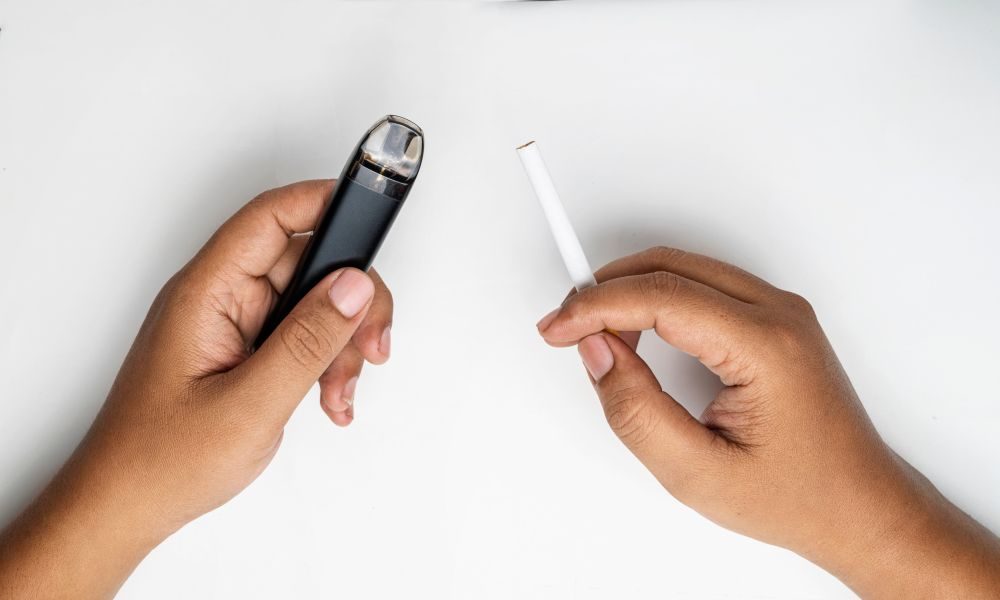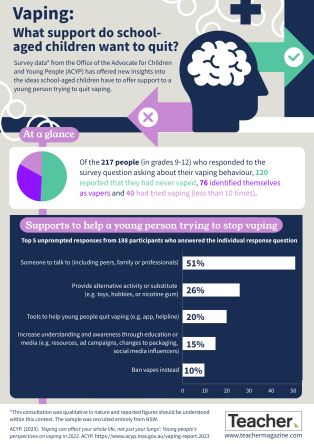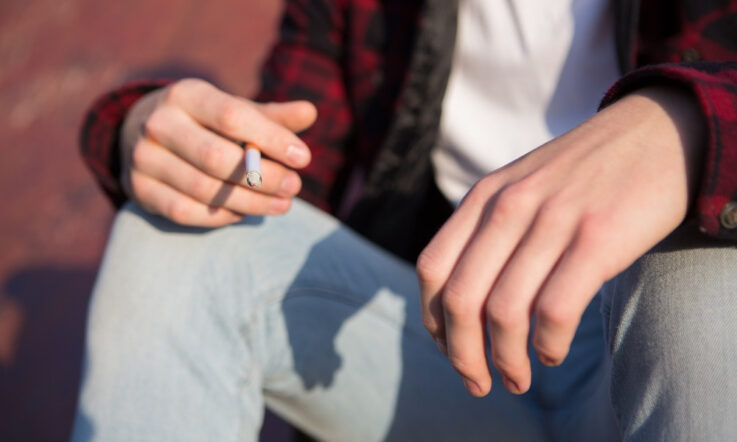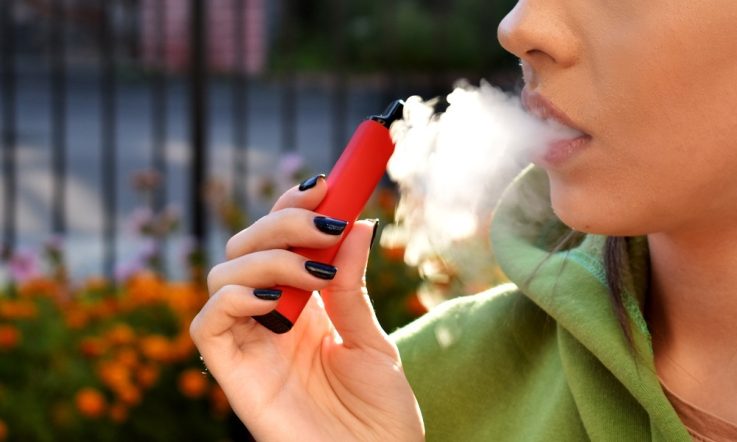Sometimes students make a behaviour choice thinking it will help them fit in with their peers. A new report from Australian Council for Educational Research (ACER) and Life Ed explores tobacco and vaping use among secondary students and finds their beliefs about ‘the norm’ don’t reflect reality.
One of the big takeaways from the study is that students consistently overestimate peer cigarette and vaping use. Researchers say the findings highlight the important role of teachers in addressing student misconceptions. ‘These inflated perceptions can influence decision-making and increase risk-taking.’
Reality Now – taking a social norms approach
The Reality Now Tobacco and Vaping Report (Van Der Zant et al., 2025) shares findings from data collected through the Reality Now program, implemented by Life Ed in partnership with ACER. The program takes a social norms approach (SNA), meaning it’s focused on identifying and correcting students’ misperceptions about peer norms (Ahmed et al., 2018).
The prevention program is delivered at schools in New South Wales and South Australia. Program sessions include the capture of anonymous real-time responses from students on substance use. ‘[The survey] asks them to consider what they do, and what they think their peers do, regarding the use of tobacco, vaping, alcohol and other drugs,’ the report explains. ‘When students realise that the majority of their peers are making healthy choices, they are more likely to follow suit.
‘Educationally, the program aims to foster critical thinking and awareness among students about their perceptions and behaviours related to tobacco and vaping. By engaging students in reflecting on actual peer norms versus perceived norms, it promotes healthier attitudes and decision-making.’
Digging into the data
Researchers analysed nearly 30,000 survey responses from students in years 7 to 11 at 135 schools across all sectors between 2018 and 2024. Although the Reality Now program also explores the use of alcohol, cannabis and MDMA, this new report focuses on tobacco and vaping.
When it comes to vaping (first included in the survey in 2021), 74% of students reported never trying it, but they thought only 10% of their peers had never vaped.
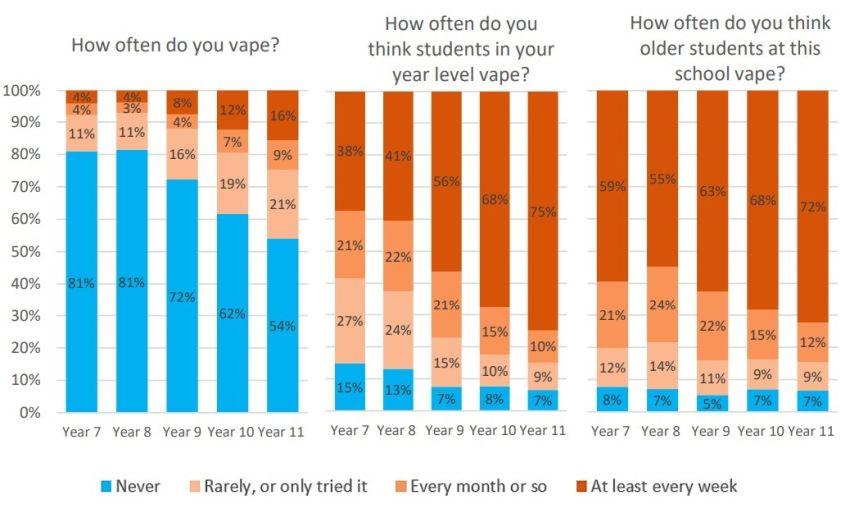
[Rates of self-reported vaping and assumed peer vaping across year levels. Source: Van Der Zant et al., 2025. Figure 2]
Only 13% agreed or strongly agreed with the statement ‘it is okay to vape’ while 51% strongly disagreed. For those who were vaping, the data show use increases with age. ‘While only 4% of Year 7 and 8 students reported vaping weekly, this proportion rose to 16% by Year 11,’ the report says.
Female students were more likely to report having tried vaping (29% compared to 23% of male students) and at least weekly use (8% compared to 6%).
Researchers say rates of cigarette use were substantially lower; more than 20% reported at least trying them and almost 3% report weekly use. Like vaping, student beliefs about peer behaviour didn’t reflect the reality – 60% believed their peers had tried cigarettes and 10% thought they were smoking at least every week.

[Rates of self-reported cigarette use and assumed peer cigarette use across year levels. Source: Van Der Zant et al., 2025. Figure 3]
Again, self-reported cigarette use increased with age. ‘While only 2% of Year 7 and 8 students reported smoking cigarettes weekly, this proportion rose to 6% by Year 11,’ the report says.
The data show only small differences between the genders – 12% of female students and 11% of male students reported trying cigarettes, while 2% of females and 3% of males reported smoking at least weekly.
Implications for teachers and schools
The report discusses implications for teachers and students, in addition to parents and families and other education stakeholders, such as policymakers. It says there’s a need for collaboration across schools, families and the wider community.
Schools are encouraged to consider evidence-based programs to support students with their decision-making. ‘For teachers, this research highlights the importance of addressing students’ misconceptions about peer behaviour through education and social norms interventions, which can foster healthier choices,’ the authors say.
‘Educators play a key role in creating open, supportive discussions that challenge misconceptions and build student confidence. Reinforcing key messages delivered by expert presenters strengthens the opportunity to change student behaviour that has lasting impact.’
References
Ahmed, S. K., Mitchell, P., & Trevitt, J. (2018). Social norms approach in secondary schools: literature review. Australian Council for Educational Research. https://research.acer.edu.au/well_being/9/
Van Der Zant, T., Hooper, T., Dix, K., & Carslake, T. (2025). Reality Now: Tobacco and Vaping report. Australian Council for Educational Research. https://doi.org/10.37517/978-1-74286-791-5
The authors of this ACER report note, ‘Educators play a key role in creating open, supportive discussions that challenge misconceptions and build student confidence.’
How do you create a supportive classroom environment for student discussions? What ground rules need to be in place for these discussions to be successful? How do you ensure students who feel more comfortable contributing anonymously are included?
